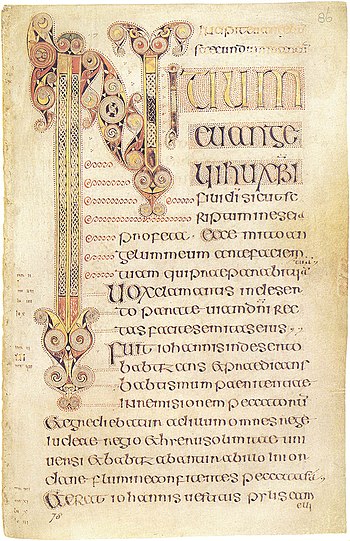Last time I mentioned that many Pictish sites have been badly damaged by subsequent habitation and erosion. But there was an even more important source of damage – antiquarianism. Prior to the 1950s the vast majority of the “archaeology” that was done in the Pictish areas (and a good portion of the rest of the world) was done by English antiquarians. Semi-educated, and extremely prejudiced individuals, who totally discounted the cultural value of Irish, Scottish, and Welsh cultural achievements. This became very obvious to me several years ago when I started receiving questions about authentic pre-1600 Irish and Scottish clothing. People were relying on books that were written in English, and there just wasn’t anything of academic quality available.
A typical example of antiquarian prejudice was expressed by E. A. Lowe in 1935. The origins of manuscripts were to be distinguished by what might be called the “Tidiness Principal”. Messy Insular manuscripts were necessarily Irish, while those which were neat and tidy were, by definition, English or Anglo-Saxon. Unfortunately this publication enjoyed a second edition in 1972, reinforcing that sentiment for some.
For those who may not have heard the term “Insular Art” before, let me provide a definition. Wikipedia says “Insular art, also known as Hiberno-Saxon art, is the style of art produced in the post-Roman history of Ireland and Britain. The term derives from insula, the Latin term for “island”; in this period Britain and Ireland shared a largely common style different from that of the rest of Europe.” If you are interested in the rest of their article, here is the link, which does have lots of good pictures.
Some progress was made in the 1940’s and early 1950’s in the area of accepting the importance of pagan art’s contribution to Insular Art. After World War II the publishing of information about the Sutton Hoo made it impossible to deny the importance of the influence of Anglo Saxon pagan art to the development of early Medieval Insular Art. And in 1959 the discovery of St Ninian’s Treasure in Scotland cemented the importance of Pictish art as an important contributor to the development of the Insular Art.
So what now? Well a large number of purposeful, but largely unscientific, excavations were done by antiquarians in the 1800’s. Many of the most obvious geographic features contained small cemeteries, many of which appear to have been Pictish. These archaeological sites were destroyed by these people, with the added help of road construction and regular building construction. The descriptions left by the antiquarians usually discuss the orientation of the burials, and the position of the bodies at interment, but any artifacts that might have been found are usually long gone, along with the skeletons.
The last thirty years has seen a major uptick in serious archaeological surveys, whose goals are the actual understanding of the surviving archaeological sites, without any concerns for who may have created them. But the problems created by previous generations still exist. Just trying to find good references is a serious challenge.
Next Time: Where do I go for real references?




